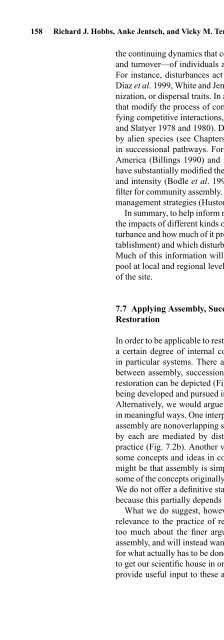Linking Restoration and Ecological Succession (Springer ... - Inecol
Linking Restoration and Ecological Succession (Springer ... - Inecol
Linking Restoration and Ecological Succession (Springer ... - Inecol
Create successful ePaper yourself
Turn your PDF publications into a flip-book with our unique Google optimized e-Paper software.
158 Richard J. Hobbs, Anke Jentsch, <strong>and</strong> Vicky M. Temperton<br />
the continuing dynamics that control the community assembly—establishment<br />
<strong>and</strong> turnover—of individuals <strong>and</strong> the successional dynamics of communities.<br />
For instance, disturbances act directly as filters on plant traits (Keddy 1992,<br />
Díaz et al. 1999, White <strong>and</strong> Jentsch 2004), e.g., on survival, reproduction, colonization,<br />
or dispersal traits. In addition, disturbances are dynamic mechanisms<br />
that modify the process of community assembly through time, e.g., by modifying<br />
competitive interactions, successional pathways, <strong>and</strong> trajectories (Noble<br />
<strong>and</strong> Slatyer 1978 <strong>and</strong> 1980). Disturbances also modify the process of invasion<br />
by alien species (see Chapters 3 <strong>and</strong> 6), which may lead to sudden changes<br />
in successional pathways. For example, introduced grasses in western North<br />
America (Billings 1990) <strong>and</strong> invasive exotic trees in the Florida Everglades<br />
have substantially modified the fire regime in that they increased fire frequency<br />
<strong>and</strong> intensity (Bodle et al. 1994), thereby modifying the limiting disturbance<br />
filter for community assembly. Disturbance-mediated invasion calls for flexible<br />
management strategies (Huston 2004).<br />
In summary, to help inform restoration projects, we need to learn more about<br />
the impacts of different kinds of disturbance as a tool in restoration: which disturbance<br />
<strong>and</strong> how much of it produces desired effects (such as native species establishment)<br />
<strong>and</strong> which disturbance tends to favor the invasion of alien species.<br />
Much of this information will, of course, depend on the surrounding species<br />
pool at local <strong>and</strong> regional levels, but inevitably also on the disturbance regime<br />
of the site.<br />
7.7 Applying Assembly, <strong>Succession</strong>, <strong>and</strong> Disturbance Concepts to<br />
<strong>Restoration</strong><br />
In order to be applicable to restoration, theoretical considerations need to reach<br />
a certain degree of internal consistency, generality, <strong>and</strong> proven applicability<br />
in particular systems. There are a variety of ways in which the relationship<br />
between assembly, succession, <strong>and</strong> disturbance concepts <strong>and</strong> the practice of<br />
restoration can be depicted (Fig. 7.2). At worst, each area can be visualized as<br />
being developed <strong>and</strong> pursued in complete isolation from the others (Fig. 7.2a).<br />
Alternatively, we would argue that the concepts are increasingly being linked<br />
in meaningful ways. One interpretation of this is that succession <strong>and</strong> ecosystem<br />
assembly are nonoverlapping sets of ideas, but that the processes encompassed<br />
by each are mediated by disturbance <strong>and</strong> in this way feed into restoration<br />
practice (Fig. 7.2b). Another viewpoint is that succession <strong>and</strong> assembly share<br />
some concepts <strong>and</strong> ideas in common (Fig. 7.2c), while a more extreme view<br />
might be that assembly is simply a current “b<strong>and</strong>wagon” that merely restates<br />
some of the concepts originally developed in a successional context (Fig. 7.2d).<br />
We do not offer a definitive statement on which of these viewpoints is correct,<br />
because this partially depends on the experience <strong>and</strong> training of the observer.<br />
What we do suggest, however, is that such discussions actually have little<br />
relevance to the practice of restoration. The practitioner really will not care<br />
too much about the finer arguments distinguishing between succession <strong>and</strong><br />
assembly, <strong>and</strong> will instead want to know what the theoretical discussions mean<br />
for what actually has to be done in real-world applications. Therefore, we need<br />
to get our scientific house in order <strong>and</strong> clarify where concepts <strong>and</strong> theories can<br />
provide useful input to these applications. In this chapter, we have attempted

















